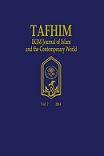INFLATION: LESSONS FROM AL-MAQRĪZĪ
Main Article Content
Abstract
Article Details

This work is licensed under a Creative Commons Attribution-NonCommercial-ShareAlike 4.0 International License.
References
Albanesi, Stefania. “Inflation and Inequality.” Journal of Monetary Economics (Elsevier) no. 54 (2007): 1088–1114.
Allouche, Adel. Mamluk Economics: A Study and Translation of alMaqrīzī’s Ighāthah. Salt Lake City: University of Utah Press, 1994.
al-‘Asqalānī, Ibn Ḥajar. Inbā’ al-Ghumr bi Abnā’ al-‘Umr, ed. Ḥasan Ḥabshī, 4 vols. Cairo: Lajnah Iḥyā’ al-Turāth al-Islāmī, 1969–1997.
Ayalon, David. “Studies on the Structure of the Mamluk Army–I.” Bulletin of the School of Oriental and African Studies, University of London 15, no. 2 (1953): 203–28.
Bacharach, Jere L. “Circassian Monetary Policy: Copper.” Journal of the Economic and Social History of the Orient (Brill) 19 no. 1 (1976): 32–47.
______. “Circassian Monetary Policy: Silver.” The Numismatic Chronicle 11, 7th series (London: London Numismatic Society, 1971) 278–280.
Balog, Paul. 1961. “History of the Dirhem in Egypt from the Fāimid Conquest until the Collapse of the Mamlūk Empire.” Revue Numismatique 3: 109–146.
Bulir, Ales. “Income Inequality: Does Inflation Matter?” IMF Staff Papers (Palgrave Macmillan on behalf of the IMF) 48 no. 1 (2001): 139–159.
Dabla-Norris, Era, Kalpana Kochhar, Frantisek Ricka, Nujin Suphaphiphat, and Evridiki Tsounta. “Causes and Consequences of Income Inequality: A Global Perspective.” IMF Staff Discussion Note. (June 2015): 42.
De la Torre, Olivia Orozco. “Monetary Thought in Islamic and Christian Scholars (13th–16th century): A Comparative Perspective on Debasement and the Rise of the Quantity Theory of Money”. (PhD diss., European University Institute, 27 June 2008).
Foss, Clive. “The Coinage of the First Century of Islam - Stephen Album and Tony Goodwin, Sylloge of Islamic Coins in the Ashmolean Museum Volume 1: The PreReform Coinage Of The Early Islamic Period (Ashmolean Museum, Oxford 2002).” Journal of Roman Archaeology 16 (2003): 748–760.
Ghosh, Atish, and Phillips Steven. “Warning: Inflation May Be Harmful to Your Growth.” IMF Staff Papers, (December 1998).
Hewlett, Sylvia Ann. “Inflation and Inequality.” Journal of Economic Issues. (June 1977): 353– 368.
Hinz, Walther and Muhammad Ismail Marcinkowski. Measures and Weights in the Islamic World: An English Translation of Walther Hinz’s Handbook Islamische Masse und Gewichte. Kuala Lumpur: ISTAC, 2003.
Ireland, Peter. “The Classical Theory of Inflation and Its Uses Today.” Shadow Open Market Committee Meeting. New York: Economic Policies for the 21st Century, 2014.
Islahi, Abdul Azim. “Economic and Financial Crises in FifteenthCentury Egypt: Lessons From the History.” Islamic Economic Studies 21 No. 2 (2013): 71–94.
Keynes, John Maynard. Essays in Persuasion. New York: W. W. Norton & Company, Inc., 1963.
______. The General Theory of Employment, Interest and Money. Cambridge: Palgrave Macmillan, 2018.
Kochhar, Rakesh. A Global Middle Class Is More Promise Than Reality. Last Modified August 13, 2015. https://www.pewresearch.org/global/2015/07/08/a-global-middle-class-is-morepromise-than-reality/. Accessed 30 December 2019.
Krugman, Paul. “The New York Times.” The Conscience of a Liberal. 7 July. https://krugman.blogs.nytimes.com/2009/07/07/the-paradox-of-thrift-for-real. Accessed 17 December 2019.
al-Manāwī, Muḥammad Ḥamdī. Nahr al-Nīl fī al-Maktabah al-’Arabiyyah. Cairo: al-Nāshir al-Dār al-Qawmiyyah alṬabā’ah wa al-Nashr al-Qāhirah, 1966.
al-Maqrīzī, Taqī al-Dīn Aḥmad Ibn ‘Alī. Ighāthah al-Ummah bi Kashfi al-Ghummah. Edited by Jamal al-Din al-Shayyal Muhammad Muṣṭafā Ziyādah. Cairo: Maṭba’ah Lajnah al-Ta’lif wa al-Tarjamah wa al-Nashar, 1954.
______. al-Nuqūd al-Islāmiyyah al-Musammā bi-Shudhūr al-’Uqūd fī Dhikr al-Nuqūd. Edited by Muhammad al-Sayyid ‘Ali Bahr al-’Ulum. Najaf: Manshūrāt al-Maktabah al-Ḥaidariyyah wa Maṭba’atuhā fī al-Najaf, 1967.
______. Kitāb al-Sulūk li-Ma’rifati Dual al-Mulūk. Edited by Sa’īd ‘Abd al-Fatāh ‘Asyūr Muḥammad Muṣṭafā Ziyādah. 4 vols. Cairo: Maṭba’ah Dār al-Kutub, 1972.
______. Kitāb al-Mawā’iẓ wa al-I’tibār bi Dhikr al-Khiṭaṭ wa al- Āthār. Reprint from the Būlāq edition with offset. 4 vols. Cairo: General Organization for Cultural Centers, n.d.
Meloy, John L. “Copper Money in Late Mamluk Cairo: Chaos or Control?” Journal of the Economic and Social History of the Orient 44, no. 3 (2001): 293–321.
______. “The Merits of Economic History: Re-Reading alMaqrīzī’s Ighāthah and Shudhūr.” Mamlūk Studies Review 7, no. 2 (2003): 183–203.
Mohamad Rabie, Hassanein. 1968. “The Financial System of Egypt 564–741 A.H./ 1169–1341 A.D.” PhD diss., University of London.
Orrell, David. Economyths: Ten Ways Economics Gets It Wrong. Ontario: John Wiley & Sons Canada, Ltd., 2010.
Petry, Carl F and M. W. Daly, ed. The Cambridge History of Egypt. 2 vols. Cambridge: Cambridge University Press, 1998.
Pew Research. “World Population by Income”. Last Modified 8 July 2015. https://www.pewresearch.org/global/interactives/global-population-by-income/. Accessed 30 December 2019.
Sabra, Adam. Poverty and Charity in Medieval Islam: Mamluk Egypt, 1250–1517. Cambridge: Cambridge University Press, 2000.
Shoshan, Boaz. “From Silver to Copper: Monetary Changes in Fifteenth-Century Egypt.” Studia Islamica. (Maisonneuve & Larose) no. 56 (1982): 97–116.
______. “Exchange-rate Policies in Fifteenth-Century Egypt.” Journal of the Economic and Social History of the Orient 29, No.1 (Feb., 1986): 28–51.
Ṭūsī, Naṣīr al-Dīn. The Nasirean Ethics. Translated by G. M. Wickens. London: George Allen & Unwin Ltd., 1964.


